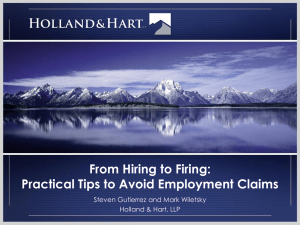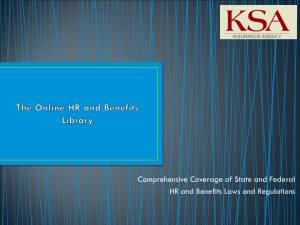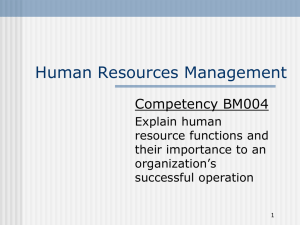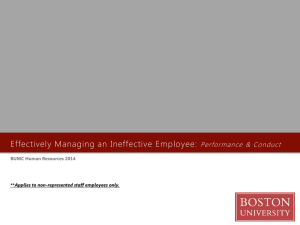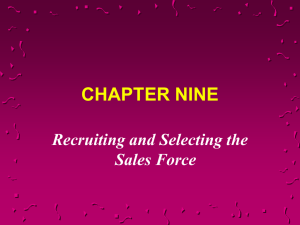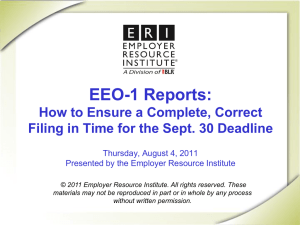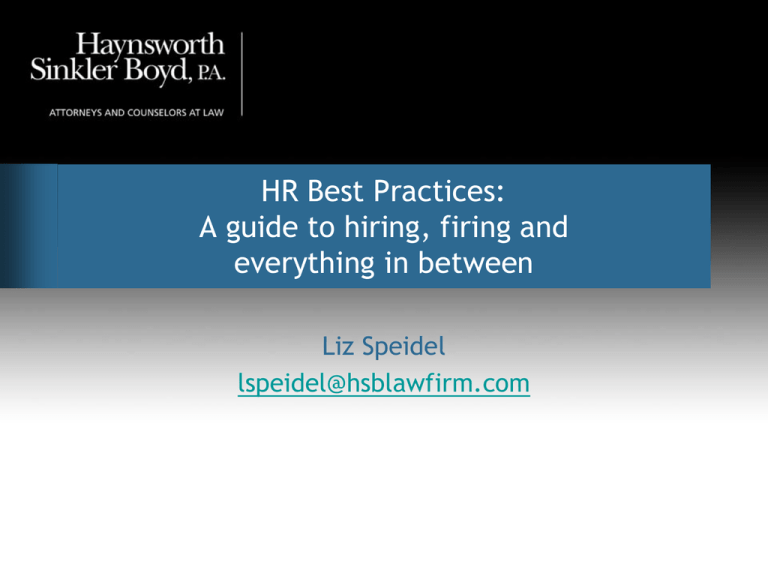
HR Best Practices:
A guide to hiring, firing and
everything in between
Liz Speidel
lspeidel@hsblawfirm.com
HIRING PRACTICES
Application Process
•
•
•
•
•
Applicant tracking is crucial.
How do you define an “applicant”?
Do you accept unsolicited applications?
How long do you keep applications?
When a position becomes available, do you review previously
received applications?
• Are applicants only/predominantly members of one sex or race?
• Are minorities and females who apply for jobs disproportionately
negatively rejected?
Recruiting
• Are job opportunities made equally available to
individuals without regard to race or sex?
• If job fairs are used to recruit applicants, are they
equally accessible to all individuals without regard to
race, sex, color, national origin, religion, age or
disability?
Recruiting
• If schools are used to recruit
• Do the newspapers or other
applicants, do the schools have
written periodicals used
a representative student body in
appeal to minorities and
terms of minorities and women?
women or are such groups
denied access to information
about job opportunities?
Recruiting
• Do you use State Employment Agencies as recruitment sources for
entry level positions?
• If Employment Agencies are used, have you reviewed the contracts
to ensure they include provisions that they conduct their activities
in compliance with the ADA and other equal employment laws?
• And have you provided them with a copy of your policy on Equal
Employment Opportunities?
Pre-Employment
• Have you adopted a standard application for ALL
employees?
• Have you required all applicants to complete the
standard application?
Hiring
• Is the application and hiring process centralized?
• If not, having managers been trained on proper
procedures and policies for interviewing and hiring
employees?
Hiring
•
•
•
•
•
Have you conducted a reference check?
Criminal background check?
Drug testing?
Pre-employment physical?
Applied consistently for all employees?
Hiring
• Has each employee received an employee handbook?
• Has each employee signed an employee certification
acknowledging receipt of an employee handbook and
knowledge of At-Will Employment Disclaimer?
• Has each employee signed a Confidentiality Agreement?
Hiring
• Have you properly classified the employee as exempt or non-exempt
under the FLSA?
• Have you properly classified the worker as an employee or an
independent contractor?
• Do you have completed I-9s on file for each
employee employed within 72 hrs of
employment? Have you complied with SC EVerify requirements?
• Do you have completed W-4s on file?
(Reasons for Not) Hiring
• Have you documented the reasons
for not hiring an applicant?
• Have you reviewed those reasons to
see if any of them are applied to
minorities or women more often
than to non-minorities or men
(adverse impact analysis)?
• Note: the EEOC and OFCCP strongly
encourage the use of internal audits
to measure systemic discrimination.
• Considered a “best practice”.
Job Descriptions
• Are your job descriptions outdated and
inaccurate?
• Do they accurately describe the essential
functions of the jobs as they are being
performed today?
• Do they specify the minimum job-related
qualifications for the job (educational
requirements; licenses; experience)?
Interviews
• Is your interview process standardized and job-related?
– Standard evaluation form for interview notes
– Notes should not contain inappropriate comments, subjective,
non-job related comments.
– Standard evaluation form should be filled out, signed and
submitted by the interviewer.
Interviews
• Have you provided training and guidance to individuals conducting
interviews as to the types of questions which can and cannot be
asked?
• Do you provide interviewers with copies of the relevant job
description (s), job notices and job postings?
• Is your interview site readily accessible?
Pre-Employment Medical
Examinations
• Why? Drug Testing? Fitness for Duty?
• All similarly situated employees subject to the same examination?
• Have you extended an offer of employment and specifically stated
that such offer is contingent upon the results of the examination?
• Is the examiner provided with information about the essential job
functions to be performed (written description or videotape
description?
EMPLOYMENT
Employment Policies
• At-Will Disclaimer
– CONSPICUOUS? On First Page?
Signed by Employee?
• Equal Employment
Opportunity?
• Drug Testing Policies &
Procedures?
• Computer and Telephone
Usage Policies?
• Privacy Policy
•
•
•
•
•
•
•
Access to Personnel Records?
Time-Off?
Leaves of Absence?
FMLA
Discipline and Termination?
Wage Payment Form?
FLSA Overtime Policy?
Employment Policies
• Non-Discrimination/Non-Harassment Policy?
– Define, including sexual, in understandable terms and include
internal complaint procedure
– No retaliation for complaints
– Sanctions for harassing/discriminatory conduct, up to &
including termination of offending employees
– Designate individual to conduct investigations & monitor
complaints of harassment
– Provide training
– Post policy in common areas.
Compensation and Benefits
• Review employee wages
• Compensation Disparities that are
gender/race/etc. based?
• Bonus Compensation – Written Policy
• Workers’ Compensation Benefits
• Short Term Disability
• Long Term Disability
• Life Insurance
Performance Evaluations
• Conduct annually, in a timely manner
• Use standardized forms to create consistency, avoid
subjective, inappropriate comments
• Develop factors used to evaluate employees that are
objective and job-related
Performance Evaluations
• Review performance evaluations to ensure they’re:
–
–
–
–
–
–
–
Completed fully;
Supported by documentation;
Based on job-related factors to evaluate the employee;
Include positive & negative assessments;
Contain no inappropriate comments;
Accurately reflect essential functions of job position as necessary; and
Followed up on.
Discipline
• Have you adopted policies and
practices with the following key
elements in mind:
–
–
–
–
Consistency;
Uniformity;
Fairness; and
Documentation?
Discipline
• Have you provided management training on how to
discipline employees in accordance with company
policy?
• Do personnel files document all employment issues
relating to performance, attendance, tardiness?
• Have you documented all disciplinary actions taken?
Written warnings/reprimands should be placed in the
employee’s personnel file.
Discipline
• Are disciplinary actions consistent with the employee’s
personnel record?
• Have you designated an individual to ensure that all
employees are treated fairly and equally and that like
offenses receive like punishment?
• Are employees given the opportunity to tell their side
of the story before disciplinary action is taken?
Discipline
• Are employees given a reasonable opportunity to
correct deficiencies, if appropriate?
• Have you consistently enforced final warnings?
• Do you follow up with employees following disciplinary
action to provide necessary training and counseling?
EMPLOYEE SEPARATIONS
Termination for Cause
• Have you created a procedure to conduct a thorough
investigation before terminating an employee?
• If a termination decision is based on a witness
statement, have you documented the witness
statement in writing?
• Does the employee’s work record and personnel file
support the decision to terminate?
Termination for Cause
• Is the decision to terminate consistent with employer
personnel policies?
• Have you reviewed terminations over the previous 12
months to ensure that protected classes of employees
are not being terminated in numbers disproportionate
to their representation in the workforce?
Involuntary Reductions in
Force
• Have you reserved the right, pursuant to written
policies disseminated to employees, to terminate
employees for no cause?
• Have you drafted written guidelines for managers and
supervisors detailing the layoff process and setting
forth the criteria to be used?
Employment Laws to
Watch Out For
•
•
•
•
•
•
•
•
•
•
•
•
•
•
•
•
•
•
•
Fair Labor Standards Act
Occupational Health and Safety Act
National Labor Relations Act
COBRA
HIPAA
ERISA
Americans With Disabilities Act
Title VII
Equal Pay Act
Pregnancy Discrimination Act
FMLA
Immigrations Reform and Control Act
Executive Order 11246 and Rehabilitation Act of 1973
WARN
Workers Compensation laws
SC Human Affairs Laws
Fair Credit Reporting Act
Employee Polygraph Protection Act
Drug Free Workplace Act
RECORD KEEPING REQUIREMENTS
Personnel Files
• What is maintained in each employee’s
personnel file?
– Are I-9 forms kept separately?
– Are medical records maintained separately &
confidentially?
• Have you adopted document retention
requirements for personnel files? Are they
being enforced?
Personnel Files
• How are you treating electronic information
maintained on each individual?
– Forms
– Email correspondence
– Applications received electronically
• What is the status upon employee termination?
– Reviewed
– Archived
– How is it stored?
Personnel Files
• Who has access to an employee’s personnel file?
– And subject to what, if any restrictions?
• What is your policy for responding to subpoenas?
DOCUMENT RETENTION
(How long do I have to keep this stuff?)
EEO-1 Filings
• 1 Year (Recommended 2 Years)
–
–
–
–
–
–
–
Employment Applications
Job Notices & Advertisements
Job Postings
Lay-off Notices
Employee Aptitude Tests
Physical Examination Results
Employee requests for Disability-Related Accommodations
EEO-1 Filings
• 3 Years from Date of Employment Action
– Payroll Records
•
•
•
•
•
•
Name
Address
Birth Date
Occupation
Pay Rate
Weekly Compensation Rate
EEO-1 Filings
• 5 Years
– Performance Evaluations
– Disciplinary Notices
– Warnings
EEO-1 Filings
• Permanent Retention (Kept in
Personnel File)
– Employee Acknowledgement
Forms - including Receipt of
At-Will Disclaimer, Receipt of
Sexual Harassment Policy &
Training.
• Duration of the Plan
– Summary Plan Descriptions
– Plan Documents
Equal Pay Act &
Fair Labor Standards Act
• 3 Years
–
–
–
–
Payroll Records
Collective Bargaining Agreements
Employment Agreements
Certificates and Notices of Wage and Hour
Administrator
Equal Pay Act &
Fair Labor Standards Act
• 2 Years
– Employment and earnings records, Timesheets, Schedules,
Wage Amendments; and
– All records that explain the basis for paying different wage
rates to employees of opposite sexes in the same
position/establishment (wage rates, job evaluations, security &
merit systems).
Equal Pay Act &
Fair Labor Standards Act
• Until Termination of Employment
– Certificates of age (i.e. voluntary request for information re:
age)
• 1 Year from Date of Termination
– Records relating to employee’s involuntary termination
Equal Pay Act &
Fair Labor Standards Act
• Duration of Training Program
– Job Descriptions
– Training Program Guides
– Interview Records
Immigration Reform & Control Act
• 3 Years from Date of Hire or 1 Year after Termination
(whichever is later)
– I-9 Forms & supporting documentation
• Copy of driver’s licenses, passports, etc.
OSHA
• 5 Years
– Annual log of all recordable occupational injuries and illnesses;
– Injury & Illness Incident Report for each occupational Injury or
Illness;
– Annual Summary of Occupational Injuries or Illnesses.
OSHA
• 30 Years
– Records documenting employee exposure to hazardous or
harmful substances and any analyses using or relying on
employee medical or exposure records
• Duration of Employment + 30 Years
– Employee Medical Records (excluding health insurance claim
records and first-aid records for one-time treatment of minor
injuries), UNLESS employee has worked less than one year.
SC Worker’s Compensation
• 2 Years
– Report of Employee work-related injury
Title VII of the Civil Rights Act and
Americans with Disabilities Act
• 1 Year from Date of Commencement of Personnel
Action
– All records relating to Hiring & Firing (applications, resumes,
promotions, demotions, transfer, layoff, discharge, pay rates)
Title VII of the Civil Rights Act and
Americans with Disabilities Act
• 2 Years from Date of Making the Record in Personnel
Action
– Records relating to EEOC Charge of Discrimination (records
relating to individual (s) filing Charge)
Uniform Guidelines on Employee
Selection Procedures
• 1 Year: Records and information showing:
– Number of persons hired, promoted, terminated for each job,
by sex, and where appropriate by race and national origin; and
– Number of applicants for hire and promotion by sex, and where
appropriate, by race and national origin; AND
– Selection procedures utilized.
Uniform Guidelines on Employee
Selection Procedures
• 1 Year from Date Record Made or Action Taken:
– Any Personnel or Employment Record made or kept by
employer (application forms; records re: hiring, promotion,
demotion, transfer, layoff or termination; rates of pay;
selection for training or apprenticeship).
Uniform Guidelines on Employee
Selection Procedures
• For 2 Years from Date Application Received or 1 Year
from Date of Report:
– All records pertaining to apprenticeship programs, including
chronological list of names, addresses of all applicants, dates
of applicants, sex and minority group identification and any
other record made solely for completing EEO-2 or similar
reports.
Uniform Guidelines on Employee
Selection Procedures
• Until Final Disposition of Charge or Action:
– Any Personnel Records relevant to EEOC Charges
• Employers with 100+ employees must maintain a copy
of their EE0-1 Employer Information Report. A copy of
the most recent report filed must always be retained
by such employer.
Executive Order 11246
• Maintain for 2 years from date record was made or
personnel action occurred, whichever is later:
– Written affirmation action programs and supporting
documentation, including required workforce analysis and
utilization evaluation.
The Age Discrimination in
Employment Act
• 3 years: Payroll or other records containing each
employee’s name, address, date of birth, occupation,
rate of pay and compensation earned per week
The Age Discrimination in
Employment Act
• 1 year from date of personnel action:
– Personnel/employment records relating to job applications, resumes,
replies to job advertisements (including temporary)
– Promotions, demotions, transfer, selection for training, lay-off, recall
or discharge
– Job orders submitted to employment agencies or unions
– Test papers in connection with employer-administered aptitude tests
– Physical exam results considered in connection with personnel actions
– Job advertisements or notices
The Age Discrimination in
Employment Act
• Until final disposition of action: all personnel records,
including above, relevant to enforcement actions
brought against the employer.
The Family and Medical Leave Act
• 3 Years (50+ employees)
–
–
–
–
–
–
Based on similar record requirements as FLSA
In addition, dates and hours of FMLA leave taken
Copies of employer notices
Documents describing employee leave benefits & policies
Premium payments of employee benefits
Records of disputes with employees over FMLA benefits

